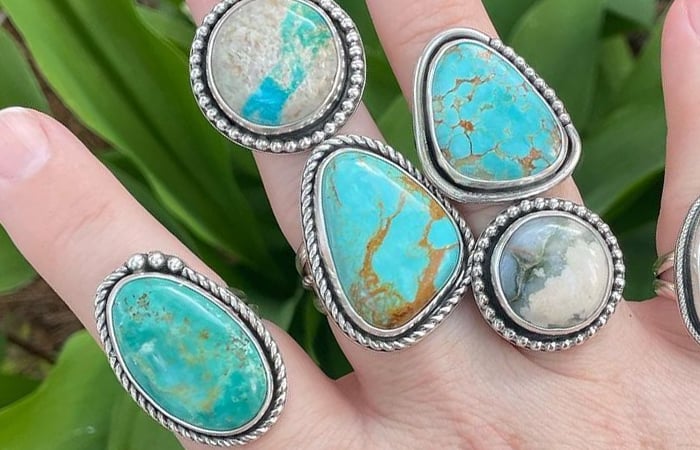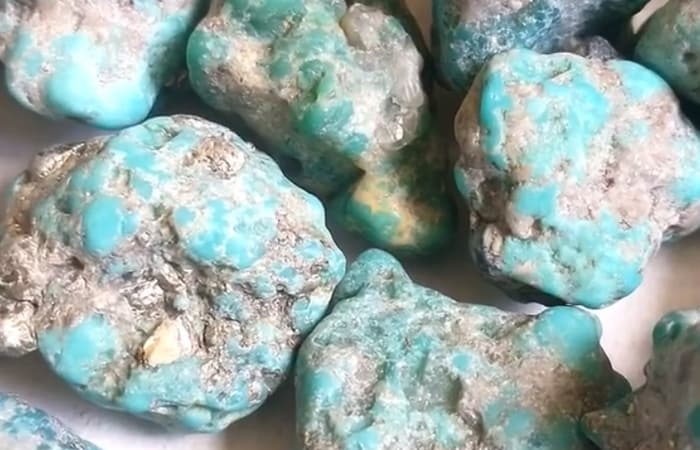Turquoise is a gemstone known for its lovely shades of blues and greens. Others have a matrix while some don’t. The matrix itself also differs a lot in terms of pattern and color. Throughout history, turquoise has been a treasured and popular gemstone. Being a water-based stone formed in rocks, the turquoise stone often features the original rock’s pieces within it.

Types of Turquoises
There are different types or variations of turquoise, and these include the following:
- Natural turquoise
- Stabilized turquoise
- Color-enhanced turquoise
- Reconstituted turquoise
- Simulated turquoise
Unlike diamonds, turquoise is porous since it has a certain amount of water content. Turquoise generally requires some form of treatment to boost its color and make this appropriate for jewelry use.
When buying turquoise, always ask how and whether the stone is treated before purchase. Natural turquoise is pricier compared to treated varieties. You also need to ensure that you don’t pay more than what you really need to.
A natural turquoise boasts a color with different intensities and is not flawlessly even, while fake stones look too perfect.
Factors to Consider when Buying Turquoise
Similar to other gemstones, turquoise has specific features that define the quality of the stone. The quality and grade can vary dramatically from one turquoise piece to the next, and so does the price of every stone. Depending on the specific mining location of the stone, its hardness, and its color, pricing can go from several dollars per carat up to around $80 per carat for collectible stones.
A turquoise stone’s grade is an indication of its quality. Stones of the highest quality often come from a certain location and are generally given grades of either AAAA, AAA, or AA. It includes stones with webbing, have unusual or bold colors, or can take a high polish.
Turquoise with AA or higher quality is often hard to find. The standard turquoise with jewelry-grade merits a grade of C, B, A, or AA-. Stones with lower grades should undergo treatment before they can be used for jewelry purposes which often reduces their price.

Colors
Turquoise is by far the only gemstone in the world with a color named after it. This stone is often combined with chrysocolla or malachite resulting in a green and blue mottled appearance. Turquoise discovered in the USA has iron content instead of aluminum, so it is often a mixture of chalcosiderite and turquoise.
Since turquoise contains color, its color is green. It is rare to find pure blue turquoise and the stone is mainly interspersed with black, dark-grey, or brown veins which can be dense or sparse. These veins can be the host rock or other turquoise and minerals containing veins called turquoise matrix. Sky-blue, also known as Persian blue or robin’s egg blue, is the most popular turquoise color, followed by apple-green or blue-green.
Clarity
Turquoise can be opaque to translucent although it is rare to find translucent materials. it boasts of a waxy to matte luster. Many turquoise stones have black, brown, or dark-grey veiny matrix inclusions or other minerals. The inclusions can be dense or sparse.
Translucent, vein-free, and pure turquoise is the most desirable variety. But there are also instances when veined turquoise features attractive patterns that increase its desirability like spider web turquoise or also known as cobweb turquoise matrix with stunning web-like patterns.

Cut
Turquoise is mainly cut en cabochon for necklace or pendants, brooches, earrings, rings, bracelets, and belts. The stone may also be cut into fancy or oval cabochons. Since turquoise is among the softer gemstones, this can also be used for an inlay or carved into ornamental items. The spherical turquoise beads are popular as well for necklaces, earrings, and bracelets as are turquoise chips and tumbled turquoise pieces.
Carat Weight
Carat weight plays a major role in defining the price of turquoise stones. Due to the rarity of fine quality large turquoise pieces, the price of these stones increases significantly for larger-sized gemstones with uniform clarity and color. These larger pieces are often considered bracelet-size stones. To verify cost and quality, it is a must to request certification from the gemstone trader or supplier for the clarity, origin, and color of turquoise.
Setting
Turquoise can go well with white gold, silver, and platinum. However, yellow gold is the choice that makes the blue color of turquoise truly pop, resembling the rays of the sun as it reflects on waves. Gold is also a more ideal choice than silver for turquoise engagement rings as well as other valuable pieces of jewelry.
While the practice of setting turquoise stones in silver has long been a tradition in the US, by tradition, jewelers set these gemstones in gold, often with diamonds, in Iran as well as in the Middle East. Even if turquoises do have certain physical limitations when used as stones for jewelry, they can make amazing additions to your jewelry collection with proper care, treatment, and cutting.
Conclusion
When buying turquoise, remember that the most prized color of this stone is intense and even medium blue. However, some consumers want a greenish blue hue while other modern designers actively search for lime green and avocado turquoise. Turquoise colors range from blue to green, and in general, the most valuable shades are pure saturated blue.
Turquoise stones can be opaque to semi-translucent, often light to greenish blue or medium blue. The stone may also have matrix veins that run through it. Matrix is the remnant of the surrounding rock. The spiderweb turquoise features fine matrix seams that produce lovely patterns that resemble a web.
Turquoise is usually cut en cabochon, with the dome shape setting off the stone’s texture, color, and any matrix in a beautiful manner. Artisans and manufacturers also style turquoise rough into beads for strand necklaces as well as into flat tiny pieces that are common in jewelry inlays.
You can find turquoise in a wide array of sizes although it is rare to find large turquoise pieces without a visible matrix. All turquoise sizes are often used in jewelry while large sizes are popular for carvings. The evenness and quality of the color are the overriding value factors for any turquoise size.



